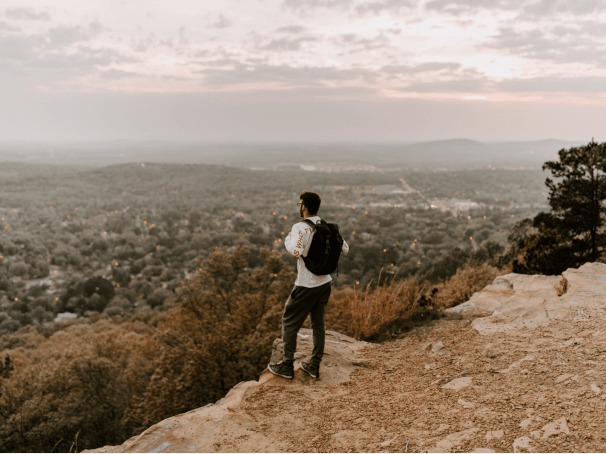
Many things in life need to cause some fear for you to stay safe. Fear is a natural part of life – a healthy warning sign that there are things in the world that represent danger. There's nothing wrong with fear. As the saying goes:
"A man without fear is a fool. A man that controls fear is a champion."
The problem isn't fear. The problem is irrational fear. The problem is when your fears cause you to change your lifestyle and run your life in a way that no fear should. When you have something – or many things – that cause you intense, irrational fear, then you have developed a phobia.
What is an "Irrational Fear?"
The word irrational can be offensive to some people. After all, the fear seems very real – and in some cases, there may be a reason to have that fear. But even a legitimate fear can be irrational depending on the way that it runs your life.
For example, let's say you have a fear of snakes – known as Ophidiophobia. Snakes can be dangerous – there are many poisonous snakes – but 99.99% of the time there are no snakes around you, and even if there were, snakes don't bite on a whim. In fact, in the United States, you have a 1 in 48,942,807 chance of being killed by a snake.
Read that again: 1 in 48,942,807.
You have a better chance of dying in an earthquake (1 in 9,788,561). You have a better chance of being struck by lightning (1 in 576,000). There are reasons that someone may want to fear a poisonous snake since snakes can be dangerous and possibly cause pain. But if you change your life to address that fear, you're likely suffering from a phobia.
There are many examples of these type of phobias. Some of them are based on real fears. Some of them are not. Examples include:
- Arachnophobia (fear of spiders)
- Acrophobia (fear of heights)
- Cynophobia (fear of dogs)
- Trypanophobia (fear of injections)
- Pteromerhanophobia (fear of flying)
- Mysophobia (fear of germs)
- Ornithophobia (fear of birds).
Phobias don't have to be common either. Almost anything can cause a phobia. There is a phobia known as hippopotomonstrosesquippedaliophobia, or "fear of long words" which, if you have that fear probably forced you to run away from your computer.
Phobias tend to fall into the following categories:
- Animal Type Phobias: Fear of dogs, cats, snakes, rats, dogs, mice, or other animals.
- Natural Environment Type: Fear of heights, firestorms, water, sickness, aging, or other natural phenomena.
- Blood-Injection-Injury Type: Fear of contamination, seeing blood, needles and similar events.
- Situational Type: Fear of closed spaces, of the dark, of going to the dentist or other situations.
- Other Type: Fear of the number thirteen, fear of clowns or mimes, fear of loud noises, and several that are difficult to categorize.
There are also some types of phobias – such as agoraphobia and social phobia – that are considered a bit different to therapists than traditional phobias and may not fall into that same category but show similarities to the phobias on the above lists.
It's not just the existence of an intense fear that causes the diagnosis of a phobia. To be diagnosed with a phobia, you need to show one or more of the following:
- You experience severe anxiety when faced with a stimulus (the thing that causes fear).
- You experience severe anxiety when anticipating the possibility of facing the stimulus.
- The fear is uncontrollable, to the point where it can escalate – possibly into an anxiety attack.
- You alter your life in some way to avoid the stimulus.
A little bit of fear may still be considered a phobia in the traditional sense, but probably won't require treatment. If you get a little scared when you see spiders but can still pick them up and throw them outside, it's still a phobia, but it's not one that plays much of a role in your life.
But if you're genuinely changing who you are because of your phobias, or you're going out of your way to avoid the fearful stimulus, or you experience severe and uncontrollable anxiety over the idea or the sight of the object that causes you fear, you have a phobia that needs help.
What Causes These Phobias?
As with most anxiety problems, it can be hard to pinpoint an exact cause of the fear. There may be some evolutionary reasons for many of these fears. At one point during evolution, there may have been reasons to fear snakes or spiders. But now those fears make less sense.
It may also be a misfiring of natural fear. There is a reason to have a bit of fear of heights, for example. Otherwise, you would be jumping off buildings or taking risks when in danger. But that fear should not be too severe. If it is, it may be a sign that your fear response is over-firing.
For others, the fear is learned. Those that have a parent that shows extreme fear at the sight of a spider will often develop their own fear of spiders. Those that have been attacked by a scary dog may develop phobias of dogs. These are all examples of learned fears.
Finally, fear may also develop out of nothing, but get reinforced by fear itself. This is why phobias are somewhat of a catch-22. What happens is the following:
- You have a fear that you know is a bit unusual.
- You tell yourself that it shouldn't cause that much fear.
- You see the object that causes fear and experience anxiety.
- Your fear is now reinforced – your brain is convinced that your response is justified. That it really IS something that you should fear. This reinforcement causes you to become more likely to fear the object or event next time.
Fear causes more fear because fear tells your mind that you're right to fear it. Your brain convinces you that you must be afraid of something very real, because otherwise why would you experience that much fear? In the end, every time you encounter your phobia (even if it's just in a dream), your fear of that stimulus becomes even more pronounced.
How Common is it to Experience a Phobia?
Because there is such a broad range of phobias in the world, nearly half of the country has some type of mild phobia. But as far as those that would be diagnosed with a specific phobia, the numbers are still very high. Some estimates put the prevalence at 11% or higher, with many more that don't report it because they don't encounter the stimulus often enough to seek help.
It may also be hard to diagnose specific phobias because the person may be suffering from other anxiety disorders. When other anxiety disorders are present, the "phobia" may be the result of other anxieties, and if you can reduce those disorders, the hardest parts of living with the phobia should go away with them.
What Treatment is There For Specific Phobias?
There are numerous treatments for phobias. Cognitive behavioral therapy is one of the best tools, as it deals with the fear itself rather than the cause, which is less unimportant for controlling phobia fears. One of the most common ways to treat phobias in known as "exposure therapy." Exposure therapy seeks to reduce the way that the phobia impacts you – causing you to face your fear in a way that is gradual and easy until the phobia treatment has had time to work effectively.
The best way to explain exposure therapy is with an example, so we'll take a look at treatment for arachnophobia (fear of spiders) and how a therapist or expert may go about reducing your anxiety:
- First, spiders need to become less of a mystery. So the therapist may have you simply learn more about them. You'll read how they work – the percentage of them that are poisonous (hint, it is EXTREMELY small), where they live, how often people are hurt by them, and so on. You'll read these until you are more comfortable with the idea of moving forward. If you feel anxiety, you'll go through relaxation strategies until you feel calm again.
- Next, you'll start imagining spiders. You'll be told to think about encountering them. Even if you feel fear, you'll be told to continue thinking about them until it no longer causes fear. The therapist or counselor will help you if you feel too anxious. You need to keep thinking about them until it almost feels silly – until the idea of a spider annoys you, and isn't something that causes any fear at all. You may also be asked to imagine them on you, etc., until the same result happens.
- Next you'll move up to start looking at pictures of different spiders. Once again, you'll keep viewing each one until they no longer cause anxiety. If you have a phobia, you'll likely feel much more anxious at the photos. But you'll talk yourself down and use your anxiety reduction strategies until you feel calmer, and once you do you'll move on to the next one. Only when photos don't cause anxiety will you move forward.
- Next comes the harder step. Your therapist will actually get a spider and put it in front of you in an enclosed location. It'll be in a cup or a tank so that it can't get on you, but you'll be asked to look at it. You'll likely feel a great amount of fear if your phobia is still very strong. Your therapist will work with you, talking you down, so that you're more comfortable around it. Eventually, being in the spider's presence where you can't avoid it will no longer lead to fear.
- Finally, in some cases, once you're able to be in the room with one, you'll be asked to go further. You may be asked to touch a spider or place one on your body. Right now, if you're afraid of spiders, the very idea will cause a great deal of anxiety. But through exposure therapy, you'll eventually control that anxiety and be able to have the object of your fear genuinely touching you without causing you to flee or experience severe anxiety attacks.
Each type of phobia has a different phobia treatment, so it won't necessarily occur exactly as described above, but exposure therapy uses this type of technique to cure people of their phobias and decrease the amount of fear they experience.
Right now, chances are this entire idea causes a great deal of fear, but rest assured that when completed in a controlled environment, this type of system has a high efficacy rate and is a great tool for combating your specific phobias.
You'll also need to control your overall anxiety since how you feel in your day to day life can also affect the degree to which your phobias affect you.












